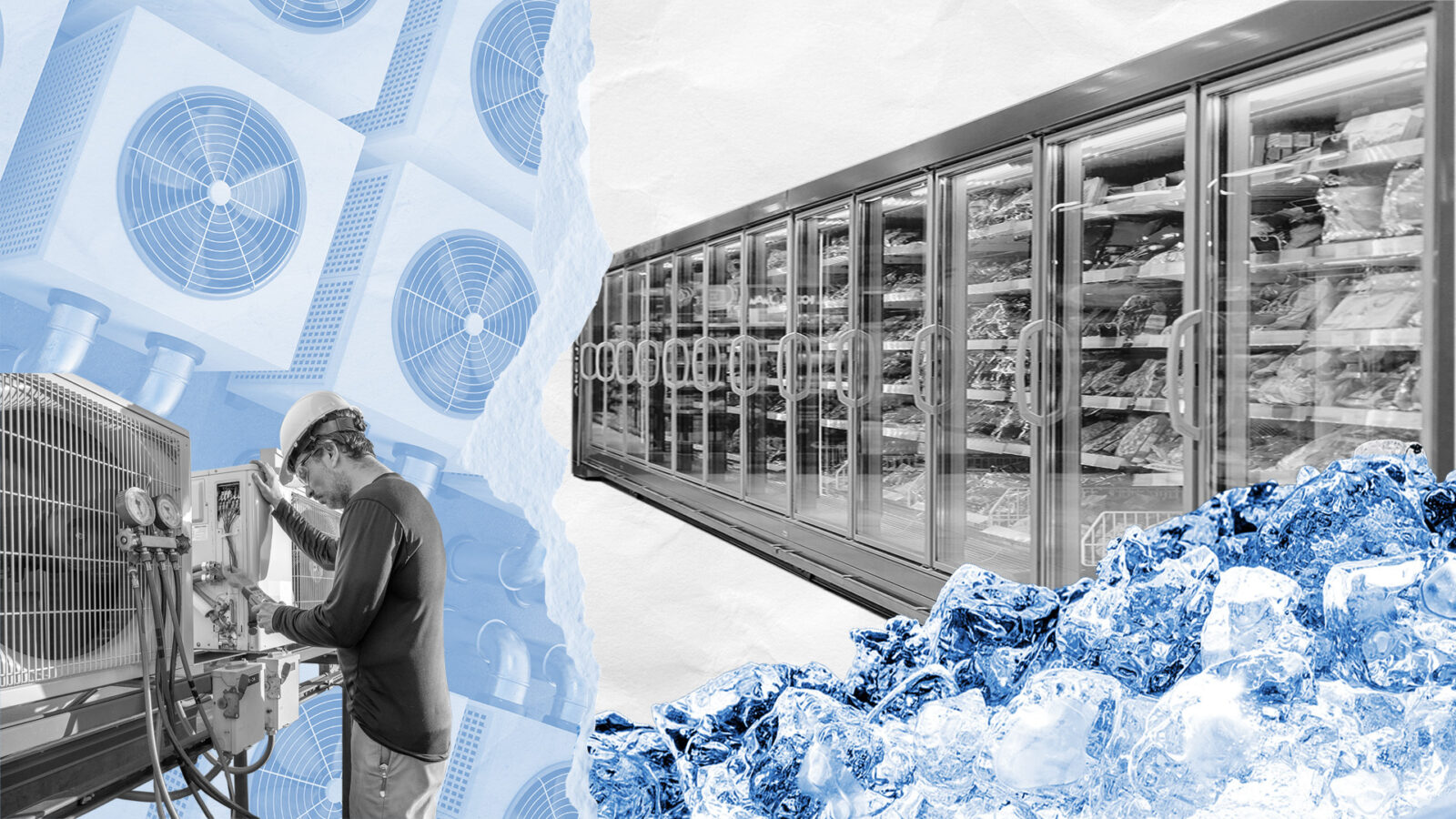Author
Greg Casto ǀ Communications Manager
Indrani Malhotra | Communications Intern
Editors
Jordan Gerow | Policy & Research Director
Ruby Wincele ǀ Policy & Research Manager
Amanda Pontillo ǀ Communications Director & Operations Lead
Climate XChange’s Dashboard Digest is a deep dive on each of the policies that we track in the State Climate Policy Dashboard and an exploration of how these policies can interact with one another to form a robust policy landscape. The series is intended to serve as a resource to state policy actors who are seeking to increase their understanding of climate policies, learn from experts in each policy area, and view examples of states that have passed model policies.
Initially heralded as a non-ozone-depleting alternative for refrigeration and air conditioning, hydrofluorocarbons (HFCs) were later discovered to be a highly potent greenhouse gas. In fact, It’s estimated that while HFCs currently only represent around two percent of global greenhouse gas emissions, a complete phaseout could avoid up to 0.5°C of warming by 2100.
It’s important that we quickly reduce HFC emissions as cooling needs rise to meet record-breaking heat. While the federal government appears to have taken a step back from regulating HFCs, states can fill the gap by restricting their use, promoting safer alternatives, and preventing leaks from existing equipment. In this article for our Dashboard Digest, we’ll dive deeper into HFCs: how they are used, how they are regulated, and how states can phase out emissions from this harmful greenhouse gas.
What are HFCs?
Hydrofluorocarbons (HFCs) are a class of synthetic gasses that are primarily used in refrigeration, air conditioning, foams, and aerosol propellants. They were introduced as a non-ozone-depleting alternative to chlorofluorocarbons (CFCs) after the Montreal Protocol was ratified in 1987 to address the growing hole in the earth’s atmospheric ozone. HFC production scaled up quickly and today they are still one of the fastest growing sources of greenhouse gas emissions.
HFCs are known as short-lived climate pollutants (SLCPs), meaning their atmospheric lifetime is relatively short compared to CO2, the primary driver of climate change. However SLCPs are extremely potent greenhouse gases and reducing their atmospheric concentration can have massive impacts in reaching climate targets. HFCs have an average atmospheric lifetime of 15 years, but their global warming potential (GWP), a measurement of their climate change-related potency, can range from hundreds to thousands of times higher than CO2 over a 20-year period. This means that pound-for-pound, HFC emissions can warm the planet hundreds to thousands of times faster than CO2.
The most common use for HFCs is as a coolant in air conditioning and refrigeration systems, and they primarily enter the atmosphere through system leaks, equipment breakdown, or mishandling of the gas at equipment end-of-life. Supermarket refrigeration is one of the largest sources of HFC emissions in the U.S., and these systems have an estimated annual leak rate of 25 percent. HFC emissions from supermarkets total 55 million metric tons of carbon dioxide equivalent (MTCO2e) each year — the equivalent to the annual emissions of 147 coal-fired power plants.
As the planet gets warmer, the demand for air conditioning and refrigeration will also rise. Fortunately there are safer alternatives that can be substituted for many of their uses. Natural refrigerants, including CO2, ammonia, and propane are readily available and all have a much lower impact on global warming than HFCs. While it would be ideal to substitute all HFCs with substances that don’t contribute to climate change, even switching to lower GWP alternatives (including other HFCs) can have major benefits.
Federal HFC Regulations
Significant New Alternatives Policy (SNAP) Program
In 1990, Congress made amendments to the Clean Air Act in response to the Montreal Protocol, one of which was to regulate ozone-depleting substances (ODSs) like CFCs and to propose safer alternatives. The Environmental Protection Agency (EPA) established the Significant New Alternatives Policy (SNAP) program, which was intended to promote a smooth transition to safer, non-ozone-depleting substances.
Through the SNAP program, the EPA establishes rules for different types of chemicals based on their end-use, and chemicals are listed as acceptable, unacceptable, or subject to use with certain limitations. SNAP Rules 20 and 21 list the restrictions on HFCs and propose alternatives based on end uses from air conditioning to foam blowing and refrigeration.
SNAP Rules 20 and 21 were partially vacated by a federal court in 2017, which ruled that manufacturers that had already been required to switch from ODSs to HFCs could not be required to again make the switch from HFCs to another alternative. They are popularly adopted as the technical basis for similar state regulations, as discussed below.
American Innovation and Manufacturing (AIM) Act
In December 2020, Congress passed the American Innovation and Manufacturing (AIM) Act, which authorizes the EPA to:
- Phase down HFC production and consumption by 85 percent by 2036. The AIM Act identifies a list of almost 20 HFCs that must be phased out during this time period. In order to achieve this target, the EPA announced the HFC Allocation Program, a cap-and-trade program for HFC allowances. Companies that produce HFC-heavy equipment (like freezer manufacturers), and companies that rely on HFCs (like grocery chains, or data centers), may both need to secure allowances under the HFC Allocation Program’s declining allowance cap.
- Regulate the management of refrigerants throughout equipment lifetime including servicing, repair, disposal, and installation. EPA is required to establish regulations to maximize reclamation of HFCs for use as refrigerants at equipment end of life.
- Facilitate the transition to next-generation technology in specific sectors, which allows the EPA to restrict HFC use on a sector or subsector basis. This created the Technology Transition Program through the EPA.
In March 2025, the EPA announced that it would reconsider the Technology Transition Rule established in the AIM Act. The Agency’s announcement implied it would promulgate a new, less restrictive rule that has fewer restrictions on technologies that commonly use HFCs, like refrigeration and semiconductor manufacturing. The AIM Act, however, contains a total phaseout schedule and instructions for how EPA should implement it, so it remains to be seen whether and how EPA might justify any substantial deviations from the intent of Congress.
What Can States Do
Phase Out HFC Use
One of the most direct ways for states to tackle HFC emissions is to set HFC phaseout targets and adopt SNAP Rules 20 and 21. In addition to preventing HFCs in newly manufactured products, these policies can also give manufacturers time to implement alternative technology.
Phaseout targets set a schedule for HFC reductions over time as a percentage of a baseline year. Phaseout targets can also help support states’ overall greenhouse gas reduction targets and may be highlighted in climate action plans. The AIM Act sets a federal schedule for HFC production and consumption by 85 percent by 2036, however it can still be important for states to adopt their own targets. State targets can both exceed the AIM Act’s schedule and may be necessary in case federal policy is weakened or overturned.
States can also adopt their own HFC alternatives programs, using SNAP Rules 20 and 21 as guidelines, or exceeding the EPA’s regulations. Although the EPA has had some challenges enforcing SNAP Rules 20 and 21, the agency’s considerable work establishing the regulations through research and public comment periods can benefit states’ own policies. California was the first state to adopt SNAP Rules in 2018, and since then, 11 other states have passed this type of legislation.
Incentivize Alternatives to HFCs
Many of the applications of HFCs, including refrigeration, aerosols, and HVAC systems, have ready-to-implement alternatives with a much lower global warming potential. Natural refrigerants like CO2, ammonia, natural hydrocarbons, water, and even air can be used for many of the same purposes as HFCs, and all have a much lower impact on the climate.
States can incentivize purchasers of HFC equipment to instead procure natural refrigerant alternatives, particularly in supermarket refrigeration. As one of the biggest emitters of HFCs, addressing leaks in supermarket refrigeration systems can be one of the most impactful and cost-effective opportunities to reduce HFC emissions. The average supermarket has an estimated HFC leak rate of 25 percent each year, contributing to 55 million metric tons of CO2e from the industry annually. While retrofitting refrigeration systems can be cost-prohibitive for businesses, states can offer rebates and pilot programs to incentivize the switch to HFC-free technology.
Purchasing and Procurement Policies
State governments wishing to lead by example can adopt procurement preferences that restrict agencies from purchasing products made with or that contain HFCs, unless alternatives are not cost effective or technologically feasible. So far, this has only been successfully accomplished in Washington, where HB 1112 (2019) requires government entities to give preference to vendors of products that are HFC-free.
Regulate Management, Recycling, and Disposal of HFC Equipment
The majority of HFC emissions today come from leaks in existing equipment or improper disposal at equipment end of life. Lifecycle Refrigerant Management (LRM), a comprehensive approach to HFC management, identifies six pillars to reducing HFC emissions, some of which can be addressed by state regulations:
- Enhance Product Stewardship: States can set up programs to encourage or require chemical and equipment manufacturers to make leak repair, HFC recovery, and proper disposal economically and technically feasible.
- Increase Refrigerant Recovery, Reclamation, and Reuse: Regulators and companies can require that certain HFC equipment only uses reclaimed refrigerants, increasing the demand for reclamation at end of equipment life.
- Leak Reduction: States can set regulations for maximum leak rates of HFC equipment and create programs to help companies identify and repair leaky equipment.
- Reporting and Enforcement: Regulators can monitor the quantity of HFCs that are reclaimed and issue penalties for entities that violate any state or federal regulations.
- Workforce Development:States can set up training programs, continuing education, and industry standards to ensure that HFC equipment is properly maintained by service professionals following LRM best practices.
- Installation and Servicing: Service professionals can ensure that HFC equipment is properly installed and maintenance is economically and technically feasible.
State Example
California
California is a national leader on regulating HFC emissions and has several legislative and regulatory approaches to meet their goals:
Forty Percent HFC Reduction Target: California Senate Bill 1383 (2016) requires the state to reduce HFC emissions by 40 percent by 2030, compared to 2013 baseline emissions. The bill also establishes targets for other Short-Lived Climate Pollutants (SCLPs) and landfill waste reduction. This target is also in line with the state’s overall greenhouse gas reduction goal of 40 percent by 2030.
Adoption of SNAP Rules 20 and 21: After the D.C. District Circuit Court partially vacated the EPA’s authority to regulate through SNAP Rules 20 and 21, in 2018, California became the first state to adopt the HFC regulations through the California Cooling Act (SB 1013). The legislation authorized the California Air Resources Board to modify the regulatory dates in the SNAP Rules to be state-specific and covers all of the SNAP Rule’s regulations with the exception of Mobile Vehicle Air Conditioning (MVAC).
Prohibition of Bulk HFC Sales: In 2022, California passed SB 1206 which prohibits the sale of bulk virgin (non reclaimed) HFCs greater than a certain GWP. The GWP limit decreases over time, effectively phasing out the worst offenders. The schedule is as follows:
- Greater than 750 GWP starting 1/1/2023
- Greater than 2,2000 GWP starting 1/1/2025
- Greater than 1,500 GWP starting 1/1/2030
HFC Recovery and Reuse: Amendments to the Clean Cooling Act established the “Refrigerant Recovery, Reclaim, and Reuse Requirements,” or R4 Program. This program requires manufacturers to prioritize reclaimed HFCs in new equipment and when servicing existing equipment.






